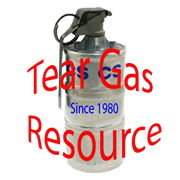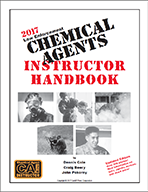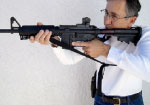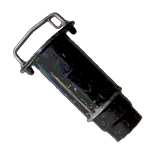Ever since the National Tactical Officers Association (NTOA) published an article (Recommendation against Concentration Calculations) in the Fall of 2005 stating that using a Lethal Concentration Formula (LCT50) was unnecessary when deploying non-lethal chemical agents a controversy has persisted. The philosophy put forward by Don Whitson in that article is one way to look at the issue. There is a second philosophy also published by the NTOA in the Fall of 1998. That article (Deployment Philosophy) by Steve Ijames suggests the use of an LCT50 formula can be helpful.
The big question is which philosophy is correct? There is some truth to both articles. To evaluate these articles you must understand what the lethal concentration formula is and how it applies to the law enforcement use of non-lethal chemical agents.
Are the chemical agents that we use truly non-lethal? Non-lethal is another controversial title. Some people will argue that if someone can die from the use of something then it cannot be “non-lethal”. Most people and the U.S. Government think that the term refers to a product designed to not have the potential to kill anyone if properly deployed and the percentage of fatal outcome is practically non-existent and the percentage of serious injury is very low (Non-Lethal.....is it a Reality?).
So, can you die from exposure to non-lethal chemical agents? Yes, you can die from breathing too much agent (Toxicity and Chemical Agents). When you get to much agent in your lungs the alveoli fill with fluid instead of air, preventing oxygen from being absorbed into your bloodstream. This condition is called pulmonary edema. Pulmonary edema can lead to respiratory failure, cardiac arrest due to hypoxia, and death.
How do you get to much agent into your lungs? You are located in an area that you cannot escape and continue to breath in airborne non-lethal chemical agents. The United States Army studied how much agent (CS) you can breathe in before you have a fifty 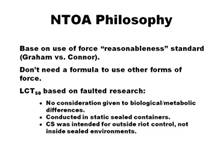 percent chance of dying from that exposure (LCT50). Sandia Labs more recently looked at the issues with CS exposure and concluded that most people will remove themselves from exposure if they are physically able to, not in locked enclosures or not hurt, before they reach lethal concentrations. (Read the Sandia study here)
percent chance of dying from that exposure (LCT50). Sandia Labs more recently looked at the issues with CS exposure and concluded that most people will remove themselves from exposure if they are physically able to, not in locked enclosures or not hurt, before they reach lethal concentrations. (Read the Sandia study here)
When dealing with a barricaded suspect we often times have them in an area they cannot escape from or choose not to escape from or they are injured inside a building and are physically unable to escape from the building. If we insert a non-lethal chemical agent into that structure or any structure, how much should we use? Some agencies just keep putting agent into a structure until they see smoke coming out of every nook and cranny. Other agencies use everything they have in their arsenal. Either approach can lead to toxic poisoning of someone trapped inside the structure. NTOA feels that non-lethal chemical agents are so safe you don’t have to worry about how much you put in a structure.
 Several instances of people dying from exposure to CS have been recorded. According to the Bertrand Russel Tribunal its use by the U. S. forces in the Vietnam War resulted in more than 689 casualties. These conclusions are bolstered by the British Government report on the use of CS.
Several instances of people dying from exposure to CS have been recorded. According to the Bertrand Russel Tribunal its use by the U. S. forces in the Vietnam War resulted in more than 689 casualties. These conclusions are bolstered by the British Government report on the use of CS.
In the USA, at least 5 casualties were reported from 1960-1978, mostly in prisons. In Mississippi recently there is a case of a home owner that went into her home after a barricaded suspect was removed from it and she died from exposure to the residual CS. She had a pre-existing injury.
November 2012 "U.S. Marine Corps Amphibious Reconnaissance (Recon) students requiring hospitalization with pulmonary edema after strenuous exercise following exposure to o-chloro-benzylidenemalonitrile."
In Palestine, according to Amnesty International about 80 people died from "tear gas" 1987-1990. Plus according to other reports at least 5 more from 2000-2001. In Germany, a policeman died in the early 1970’s, and a demonstrator in 1986. After an army instructor died of Morbus Hodgkin’s, in 1987 an insurance court ruled the most probable cause was contact with "tear gas". In 1999, twenty casualties were reported in Turkey after one single deployment of "tear gas". In Egypt 2013 Los Angeles Times reports; “Overnight, one woman in her 30s died after she suffocated from the tear gas, said Dr. Ibrahim Al Yamani, who is in charge of documenting the casualties inside.” More casualties were reported from Ireland, France, Germany, Switzerland, South Africa, Bahrain, Bolivia, Ecuador, Sarawak and Nigeria. In the Middle East today there are numerous reports of people being injured and dying from exposure to CS.
Egypt 2013 - The final forensics reports of last week's Abu Zaabal incident where 37 prisoners were killed have shown that the deaths were caused by suffocation from tear gas. The reports said that the victims sustained no burns or bullet wounds on their bodies, Al-Masry Al-Youm reported, adding that the teargas that killed the victims is known as "CS". Thirty seven supporters of ousted President Mohamed Mursi were killed last week when security forces tear gassed them during their attempt to escape detention, the interior ministry had reported.
Seven years ago, the IDF Medical Corps published a study on CS gas in both the Israeli medical journal "Refuah" and the overseas journal "Archives of Toxicology." That study, based on animal experiments, concluded that to kill a person, you would need a dose 800 to 5,600 times larger than the quantities used to disperse demonstrations. Nevertheless, it added, a high concentration of the gas in a given location could cause serious or even lethal harm, and therefore, the gas cannot be considered innocuous.
There are many instances of people getting second and third degree burns from exposure to CS. Click here for photos.
Another issue is residual contamination inside of a building. If you use too much tear gas will you be financially responsible for decontaminating the building?
Using non-lethal chemical agents is a type of force. Anytime we use force we must use only that force which is reasonable for the circumstances. Excessive force is not subject to a precise definition, but it is generally beyond the force a reasonable and prudent law enforcement officer would use under the circumstances. Force should be used in only the minimum amount needed to achieve a legitimate purpose.
When using chemical agents how do you measure how much force is reasonable and necessary for the circumstances? Or, how much force is excessive ? Where is the level that separates excessive use of agent and a reasonable use of agent? Is it all you have in your arsenal? Is it one burning canister? Is it two burning canisters and one ferret round? Do we want some attorney deciding for us?
The U.S. government has helped in answering these questions. In a U.S. Army study they established the level of contamination needed to move 50% of people (soldiers) out of a contaminated environment (ICT50). They also established the level of agent that would kill 50% of the exposed population (LCT50).
Experience has shown that using the incapacitating doses of CS the Army found will seldom drive a determined suspect out of a structure. Remember that you must have the physical effects of the chemical agent coupled with psychological effects for the chemical agent to work. If he doesn’t feel the pain coupled with panic he probably won’t come out. Most agencies have increased the amount of agent that they use per cubic foot of space to a level that will drive a suspect out and give them plenty of time to react before someone has a 50% chance of dying from exposure to CS.
In a British report they articulate: “Our provisional conclusion is, therefore, that there is a wide margin of safety between the exposure dose of CS that produces intolerable symptoms in man and that which might be lethal.” However, in a U.S. Army report they conclude in part: “At higher levels of exposure, inhalation toxicology studies indicate CS can cause chemical pneumonitis and fatal pulmonary edema. (Victims die by drowning in their own lung fluids)”
In 1967 the U.S. Army developed the Lethal Concentration Time for exposure to CS. Their studies were based on exposing animals to CS and extrapolating that to what a human can tolerate. Their study was based in a controlled environment using persistent CS. That controlled environment was a sealed container so the level of CS could be precisely measured.
In law enforcement we never deal with a completely sealed environment. Just by the way we insert the agent we open a portal that will let fresh air in and chemical agent out. The NTOA argues that the formula the Army developed is useless because it wasn’t done in the real world using real people as guinea pigs.
If you use the more gas method of deployment or just launching all you’ve got into a structure because you think the more you use the better it will be and someone gets hurt, dies or the structure is contaminated beyond reasonable repair are you using justifiable force? Knowing that the problem exists how do we determine our prudent level of force?
If you have used excessive force will you be sued or held criminally liable for your actions? How will you defend yourself in court? How will you explain the level of force you used was justified? The level of force being the amount and type of agent you put into the structure.
More and more law enforcement agencies and officers are being sued for the use of non-lethal chemical agents. Some recent examples:
“A Derry (Pennsylvania) woman has filed a federal lawsuit against the borough and its police chief in federal court, claiming that her constitutional rights were violated when police lobbed 26 canisters of tear gas into her house during a 10-hour standoff.”
Salt Lake City - “Late yesterday, the ACLU of Utah filed a class action lawsuit on behalf of a group of prisoners at the Utah State Prison. The case involves an incident in August 2011 in which corrections officers released a tear gas canister in the Olympus wing of the Utah State Prison to subdue a single prisoner. The tear gas entered the air ventilation system and seeped into cells that have no windows or bars, affecting about 150 inmates. The inmates were left to breathe the noxious gas for about 20 minutes, and many feared for their lives. The Olympus wing is the mental health wing of the prison; it also houses prisoners with severe medical conditions.”
“Judge Kidd (Hinds County, Mississippi) found the police 50% at fault and the tear gas manufacturer 50% at fault. The basis for the claim against the tear gas manufacturer appeared to be failure to warn and breach of warranty. Total damages were $2.2 million. But with the City 50% at fault, the tear gas manufacturer (Combined Systems) owes $1.1 million. The City settled before trial.”
“Thompson (Pennsylvania) claims police had no reason to attack her house, blast it full of holes, ram it with an armored vehicle and fill it with noxious gas, especially since she had readily agreed to allow officers to enter the home and look for Gerry.”
Headwaters vs. Humboldt County; Nelson vs. City of Davis; Federated University Police Officers Association v. Superior Court (2013); Young vs. County of Los Angeles to name a few other noteworthy cases.
We must have a method to help protect ourselves from accusations of excessive force!
The LCT50 formula will give you a baseline for your use of non-lethal chemical agents. It will help determine the amount of chemical agents to use. You will estimate the time a suspect can remain in a contaminated environment. It provides a guideline for command staff and for any potential criminal and civil litigation. It should be part of your due diligence process.
If you understand the formula and how to apply it you will be able to articulate why you used the level of agent that you did. It will help show you were reasonable in your actions and you were looking out for the safety of all involved. Using this method will not prevent you from using enough non-lethal chemical agents to dislodge the suspect. It will help you articulate why you used the amount you did. It will help you in claims and law suits for excessive force.
The long and the short of things is that it is better to be safe than live with the consequences of not knowing what levels of agent are prudent and safe for you to use.
